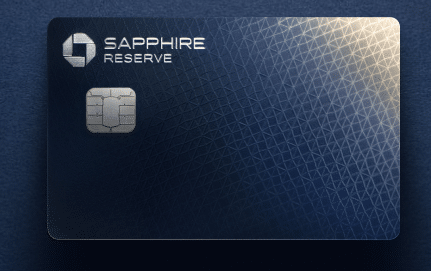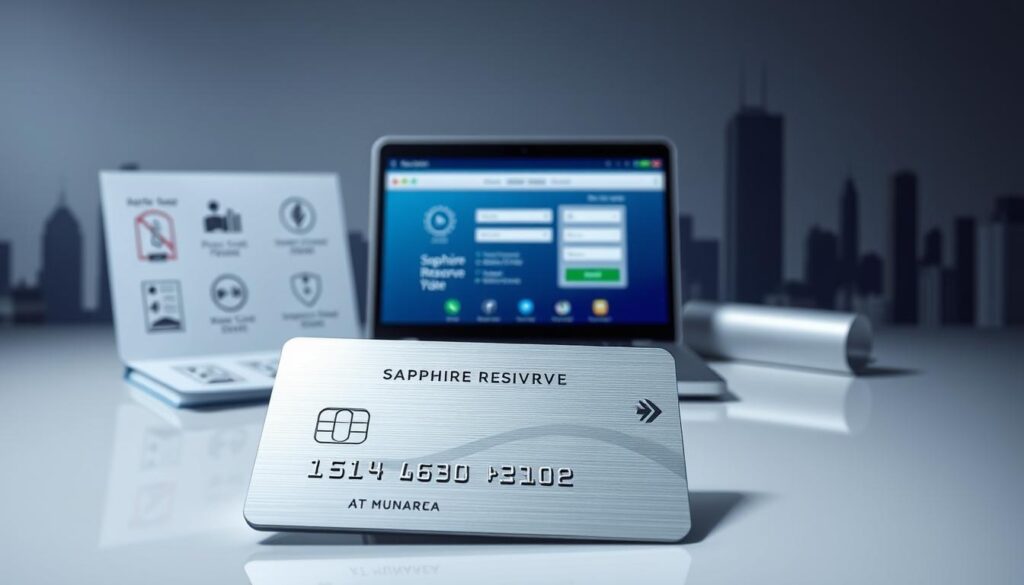Anúncios
Want to unlock top-tier travel rewards and luxury benefits?
The Chase Sapphire Reserve is a premium travel card that headlines a $300 annual travel credit. Issued by JPMorgan Chase, the Chase Sapphire Reserve pairs elevated travel and dining rewards with Priority Pass Select lounge access and a broad suite of travel protections.
This premium travel card targets frequent travelers and diners who can leverage Chase Ultimate Rewards for flexible redemptions. Cardmember materials and the benefits guide make clear the trade-off: a high annual fee in exchange for luxury travel credit, enhanced earning rates, and protections that reduce out-of-pocket risk on trips.
Market coverage from The Points Guy and NerdWallet frames the Chase Sapphire Reserve alongside other luxury-tier products, noting the $300 annual travel credit as a key offset to the fee and a primary reason many consumers choose this card. This article will explain how that credit actually works, detail secondary perks, outline earning and redemption mechanics, evaluate fees versus value, and offer application tips and real-world examples.

Chase Sapphire Reserve
Key Takeaways
- The Chase Sapphire Reserve offers a $300 annual travel credit as a headline benefit.
- It is a premium travel card best suited for frequent travelers and diners.
- Priority Pass Select lounge access and travel protections are major perks.
- Chase Ultimate Rewards powers versatile redemption options for cardmembers.
- The $300 luxury travel credit helps offset the card’s high annual fee.
The New Chase Sapphire Reserve®: Premium Travel Power Compared to Freedom Unlimited® and Flex®
When it comes to premium travel credit cards, the Chase Sapphire Reserve® remains one of the most rewarding and prestigious options on the market. Designed for frequent travelers and luxury seekers, it offers outstanding travel credits, top-tier protection, and exclusive lifestyle perks.
While Chase Freedom Unlimited® and Chase Freedom Flex® are excellent choices for cash back and everyday purchases, the Sapphire Reserve® is in a league of its own for those who want elevated rewards and experiences.

Chase Freedom
1. Chase Credit Cards Compared
| Feature | Chase Sapphire Reserve® | Chase Freedom Unlimited® | Chase Freedom Flex® |
|---|---|---|---|
| Annual Fee | $795 | $0 | $0 |
| Main Rewards | 8x on Chase Travel, 4x on flights/hotels booked directly, 3x on dining, 1x on others | 5% on Chase Travel, 3% on dining & drugstores, 1.5% on all other purchases | 5% on quarterly categories (up to $1,500), 5% on Chase Travel, 3% on dining & drugstores, 1% on others |
| Travel Credits | $300 annual travel credit, Global Entry/TSA PreCheck credit | None | None |
| Lounge Access | Priority Pass™ + Chase Sapphire Lounges | Not included | Not included |
| Insurance & Protection | Comprehensive travel & purchase coverage | Basic purchase protection | Cell phone protection, extended warranty |
| Ideal For | Frequent travelers and premium cardholders | Everyday use and simplicity | Strategic cash back earners |
2. Travel and Rewards Power
The Chase Sapphire Reserve® offers some of the highest reward multipliers among travel credit cards. With 8x points on Chase Travel, 4x on flights and hotels booked directly, and 3x on dining, it’s built for those who spend often on experiences and travel.
Points are worth 50% more when redeemed through Chase Ultimate Rewards®, making every dollar spent go further toward flights, hotels, or transfers to airline and hotel partners.
By comparison, Freedom Unlimited® keeps things simple with flat-rate cash back, and Freedom Flex® can earn more in certain quarters, but requires manual category activation.
3. Premium Perks and Lifestyle Benefits
Beyond travel rewards, the Sapphire Reserve® delivers exceptional lifestyle perks. Cardholders enjoy:
- Annual $300 travel credit automatically applied to travel purchases.
- Priority Pass™ access to 1,300+ airport lounges worldwide.
- Global Entry or TSA PreCheck credit every four years.
- Perks with Lyft, DoorDash, and luxury hotel partners.
- Comprehensive insurance for trip delays, cancellations, and lost luggage.
These features far exceed what Freedom Unlimited® or Flex® provide — making the Reserve the best Chase card for travelers in 2025.
4. Who Should Choose the Sapphire Reserve®
If you travel frequently, dine out often, and want peace of mind while abroad, the Chase Sapphire Reserve® is worth its premium annual fee. The included credits, points boost, and travel protections can easily outweigh the cost for anyone who travels multiple times per year.
For those seeking simplicity and zero annual fees, Freedom Unlimited® or Flex® remain excellent alternatives — but for luxury rewards and elite experiences, the Sapphire Reserve® stands above them all.
Overview of the Chase Sapphire Reserve Card
The Chase Sapphire Reserve overview gives a quick look at a top-tier travel card with a high annual fee and rich perks. Cardholders get strong travel protections, flexible Chase Ultimate Rewards points, and a $300 annual travel credit that often offsets much of the cost.
Key benefits at a glance
The card benefits include 3x points on travel (after the travel credit) and dining, with 1x on other purchases. Members receive Priority Pass Select lounge access for unlimited visits. A Global Entry or TSA PreCheck statement credit helps speed airport entry.
Premium protections come standard: primary rental car insurance, trip delay and cancellation/interruption coverage, lost luggage reimbursement, purchase protection, and extended warranty. Chase offers periodic sign-up bonuses for new cardmembers; check current promotions for the latest offer.
Who this card is best for
This card suits frequent domestic and international travelers who spend enough on travel and dining to justify the fee. It rewards people who value lounge access and premium travel insurance.
Cardholders who will reliably use the $300 annual travel credit, the Global Entry/TSA PreCheck credit, and Priority Pass tend to extract the most value. Travelers who want flexible point transfers to airline and hotel partners should pay attention to Chase Ultimate Rewards pairing.
How it compares to other premium travel cards
When you compare premium travel cards, the Sapphire Reserve stands out for everyday travel and dining earnings tied to Chase Ultimate Rewards. Compared to American Express Platinum, the Reserve often earns more on daily travel and dining spend while Amex focuses on lounge networks like Centurion and specific Delta access.
Citi premium cards and others differ in transfer partners and benefit mixes. Annual fees and perks vary, so prospective applicants should weigh how they plan to use benefits before choosing which card fits their travel style.
How the $300 Annual Travel Credit Works
The Sapphire Reserve’s $300 annual travel credit offsets many common trip expenses. Read the benefit terms carefully to spot which charges qualify. Merchant coding and posting behavior drive most decisions about eligible charges.
Eligible purchases and merchant categories
Chase applies the credit to purchases that post with travel-related merchant category codes. Typical eligible travel purchases include airline tickets, hotel stays, car rentals, taxis and ride-share trips, trains, buses, and tour operators. Online travel agencies such as Expedia and Booking.com usually qualify when coded as travel.
Some travel-adjacent items can qualify when they carry a travel MCC. For example, baggage fees, certain resort fees, and parking might be eligible if the merchant codes the charge as travel. Charges that post as restaurants, retail, or other non-travel MCCs may not trigger the credit, even if they occur during a trip. In-hotel restaurant bills sometimes code as dining and can be excluded.
Automatic vs. enrollment-based credits
Chase’s credit is generally automatic. Cardmembers do not usually need to enroll or toggle categories to receive the $300 travel credit. Purchases that meet the merchant category rules will trigger a statement credit up to $300 per cardmember year.
Some cards from other issuers require annual activation or category selection. Sapphire Reserve stands out because qualifying charges are processed automatically, which reduces the chance of missed credits for busy cardholders. Policies may change, so verify benefit details in your Chase account and the card’s benefits guide.
Timing of statement credits and reimbursement process
Automatic statement credit timing varies by transaction. Credits can post within a few days after a purchase posts or take several weeks when merchant processing is slow. Pending transactions typically will not show the credit until they fully post.
If a qualifying purchase is refunded or reversed, the credit may be reversed as well. For missing credits, wait for the charge to post, then check the transaction’s merchant category code in your online account. If the MCC looks incorrect or the credit still does not appear, contact Chase customer service with receipts and invoices for faster resolution.
Chase: Sapphire Reserve – Premium Travel Card with $300 Annual Credit
The card’s name signals issuer and intent. JPMorgan Chase anchors trust and scale. Sapphire Reserve indicates a top-tier, travel-focused product designed for frequent flyers and diners. The phrase Premium Travel Card with $300 Annual Credit highlights the headline reimbursement meant to offset the card’s annual fee.
What the full product name signifies
The full product name meaning points to both brand and benefit. Chase positions this as a reserve-level option in the Sapphire family. That naming conveys elevated service, flexible Ultimate Rewards points, and benefits aimed at affluent travelers.
Primary selling points emphasized in marketing
Chase Sapphire Reserve marketing centers on high earnings for travel and dining, a large welcome bonus, Priority Pass lounge access, and strong travel insurance. The metal card feel and simple redemption path through Chase’s portal play into its premium image. Marketing materials stress point transfers to airline and hotel partners at a 1:1 ratio.
Where to apply and promotional offers
Where to apply Sapphire Reserve includes Chase.com, in-branch Chase locations, and targeted prequalified offers sent by mail or email. Authorized affiliate partners sometimes run limited-time links. Applicants should review terms around welcome bonuses and eligibility before applying to confirm qualification for current promotions.
| Channel | What to Expect | Notes |
|---|---|---|
| Chase.com | Full product details, live welcome offers, secure online application | Best source for up-to-date current promotions and official terms |
| Chase branch | In-person help with questions and instant application assistance | Good for cardholders who prefer face-to-face service |
| Prequalified mail/email | Targeted offers with personalized welcome bonus amounts | May improve approval odds if prequalified through Chase |
| Affiliate partners | Occasional elevated bonuses tied to third-party promotions | Confirm offer terms and ensure legitimacy before applying |
Travel Perks Beyond the $300 Credit

The Sapphire Reserve goes past the $300 travel credit with perks that help at every stage of a trip. Cardholders gain lounge access, robust travel protections, and Global Entry or TSA PreCheck fee reimbursement. Each benefit has terms you should check before planning travel.
Airport lounge access and Priority Pass benefits
The card includes a complimentary Priority Pass Select membership for the primary cardmember and often for authorized users. That membership unlocks entry to hundreds of participating lounges worldwide, subject to each lounge’s rules and capacity. Not every airline club accepts Priority Pass, so use the Priority Pass app to confirm locations, guest policies, and hours before you go.
Travel insurance, trip delay/cancellation coverage
travel insurance Chase Sapphire Reserve features trip cancellation and interruption coverage for nonrefundable expenses when a covered reason applies. Trip delay reimbursement kicks in after the minimum delay period listed in the Guide to Benefits and can cover meals and lodging up to stated per-day limits.
The card also offers primary rental car collision damage waiver when you decline the vendor’s CDW and pay with the card. Additional protections include baggage delay and loss reimbursement, emergency evacuation, and travel accident insurance. Review limits, exclusions, and claim steps before relying on any specific coverage.
Global Entry/TSA PreCheck statement credit
Cardholders can use the Global Entry credit Chase offers to cover the application fee for Global Entry or TSA PreCheck when they pay with the card. This statement credit applies once every few years based on current Chase terms. Global Entry includes TSA PreCheck benefits after you complete the application and background check, which speeds security on domestic departures.
| Perk | What it covers | Key limitation |
|---|---|---|
| Priority Pass Select | Access to hundreds of lounges worldwide; authorized users often included | Some airline clubs excluded; guest policies vary by lounge |
| Trip cancellation/interruption | Reimbursement for nonrefundable prepaid travel for covered reasons | Limits and covered reasons defined in Guide to Benefits |
| Trip delay reimbursement | Meals and lodging after required delay period | Minimum delay threshold and per-day caps apply |
| Primary rental car coverage | Collision and theft protection when you decline vendor CDW | Certain countries and vehicle types excluded |
| Baggage delay/loss & emergency coverage | Expense reimbursement and emergency evacuation assistance | Documentation and timely claims required |
| Global Entry/TSA PreCheck credit | Statement credit for application fee when paid with card | Credit frequency limited; check current Chase timing rules |
Rewards Structure and Earning Rates
The card’s rewards system centers on elevated returns for travel and dining, with points moving into a single Ultimate Rewards account for easy management. Chase Ultimate Rewards points pile up quickly when you focus spending where the card pays more. Keep in mind that earning tiers can change, so check current terms before planning large purchases.
Points earned on travel and dining
The Sapphire Reserve earning rates typically give 3x points on travel after the $300 travel credit is used and 3x on dining points at restaurants, bars, and eligible delivery services. Those boosted categories are the fastest way to grow a balance of Chase Ultimate Rewards points.
Points on other everyday spending categories
Everyday purchases usually earn 1x point per dollar. Chase runs targeted promotions from time to time that increase earnings in specific categories. Authorized users’ spending posts to the primary account, so adding trusted family members can raise the total points earned.
How points transfer to airline and hotel partners
Chase Ultimate Rewards points transfer at a 1:1 ratio to a roster of airline and hotel transfer partners. Common options include United, Southwest, British Airways, Air France/KLM, JetBlue, Emirates, Singapore Airlines, World of Hyatt, Marriott Bonvoy, and IHG Rewards. Transfers are usually instant or very fast, which helps when award space is scarce.
Maximize value by moving points to partners for high-value award seats or premium cabin redemptions. Chase does not charge transfer fees, though carriers and hotels may impose award taxes and fees. Combining the Sapphire Reserve with a Chase Ink business card or a Sapphire Preferred can expand category coverage and boost overall returns.
| Spending Category | Typical Earning | Notes |
|---|---|---|
| Travel (after $300 credit) | 3x Chase Ultimate Rewards points | Includes flights, hotels, taxis, rideshare; verify merchant coding |
| Dining | 3x dining points | Restaurants, delivery, bars; boosts everyday dining spend |
| Other purchases | 1x Chase Ultimate Rewards points | All other eligible purchases; subject to change |
| Transfer to partners | 1:1 transfer partners | Airlines and hotels listed above; transfers often instant |
Annual Fee and Overall Value Calculation
The Chase site lists the Sapphire Reserve annual fee as $550. This section breaks down what that cost buys and how to run a clear card value calculation before you keep or cancel the card.
Breaking down the annual fee vs. benefits
Start with hard-dollar benefits. The $300 offset travel credit effectively reduces the net fee if you use travel charges that qualify. Add the value of Priority Pass lounge access, which many frequent flyers value at several hundred dollars per year when used often. Chase reimburses Global Entry or TSA PreCheck once every four years. Travel protections and purchase coverage carry implicit value that can offset unexpected costs.
Next, estimate points value. Elevated earnings on travel and dining boost point accumulation for award travel. Transferring Ultimate Rewards points to partners such as United, Southwest, Hyatt, and Marriott can create outsized redemption value. Include conservative estimates for transfer redemptions when completing your card value calculation.
Using the $300 credit to offset the cost
The $300 travel credit posts once per account year and is applied to qualifying travel transactions. To capture the full offset travel credit, charge eligible purchases like airline tickets, hotel stays, rental cars, ride-hailing and many OTA bookings. Confirm merchant coding when booking to avoid surprises.
Authorized users typically do not receive separate $300 credits under Chase’s current policy. Treat the credit as a single annual reduction when you compute net cost for a primary cardholder.
Scenario examples: when the card makes sense financially
Frequent traveler: A person who spends $6,000 on travel and $4,000 on dining will earn substantial points, use Priority Pass lounges regularly, and get Global Entry reimbursement. After applying the $300 offset travel credit and valuing transferred points for premium awards, the net return often exceeds the Sapphire Reserve annual fee.
Occasional traveler: Someone who uses the $300 credit, redeems the Global Entry credit, and visits lounges a few times may still find the card worth keeping. Modest points earnings add upside if the cardholder transfers points selectively for boosted redemptions.
Low-use cardholder: If travel and dining spending is minimal, the net benefits may not cover the fee. In that case, consider lower-fee alternatives or downgrade options that retain some Ultimate Rewards value.
| Item | Estimated Annual Value | Notes |
|---|---|---|
| Sapphire Reserve annual fee | -$550 | Listed by Chase as the current standard fee |
| Offset travel credit | $300 | Posts once per account year for qualifying travel |
| Priority Pass lounge access | $150–$400 | Value varies by usage frequency and lounge admission costs |
| Global Entry/TSA PreCheck credit | $15–$100 (annualized) | Reimbursed once every four years; averaged per year for comparison |
| Travel protections & purchase coverage | $25–$150 | Depends on claims and avoided costs |
| Points from travel and dining | $200–$1,200+ | Range reflects redemption choices and transfer value |
| Net estimated value range | $140–$1,600+ | Shows scenarios from low-use to heavy travel |
Redeeming Chase Ultimate Rewards Points
Chase Ultimate Rewards points open many doors for travel and cash value. You can redeem Ultimate Rewards through the Chase travel portal for simple, point-based bookings. Cardholders often find the portal convenient for last-minute fares and cash-priced hotel rooms.
Travel portal redemptions and value per point
Using the Chase travel portal typically gives Sapphire Reserve holders a boosted points value compared with a base card. That boost makes booking straightforward and fast. Portal bookings show cash fares instantly. Expect consistency, though peak international award seats can offer better returns elsewhere.
Transfer partners and maximizing value
Transfer to partners when you want outsized value. Airline and hotel partners like United, World of Hyatt, Singapore Airlines, and Korean Air often deliver higher returns than portal redemptions for premium cabins and boutique hotels. Monitor saver award space and move points only when a confirmed award exists.
Simple tactics increase upside. Check award calendars and use tools that track availability. Compare the cash price with the award cost after you transfer to partners. That comparison reveals real points value and prevents wasted transfers.
Non-travel redemptions and flexibility
Non-travel redemptions include statement credits, cash back, gift cards, and retail options. Those choices provide flexibility in tight situations. Expect lower points value for non-travel redemptions compared with travel uses.
| Redemption Type | Typical Points Value | Best Use Case |
|---|---|---|
| Chase travel portal | Around boosted rate for Sapphire Reserve (easy comparison) | Last-minute bookings, cash-priced fares, simple hotel reservations |
| Transfer to partners | Often highest points value for premium or international awards | Business/first class flights, World of Hyatt boutique hotels |
| Non-travel redemptions | Lower value per point, but most flexible | Statement credits, gift cards, emergency cash needs |
Eligibility, Application Tips, and Approval Odds

Before you apply, know the basics that shape approval odds. Chase looks for a strong credit history, stable income, and low credit utilization. Meeting Sapphire Reserve eligibility often means having a credit score in the mid-700s or higher and a track record that shows you can manage a premium card.
Credit score needed is only part of the picture. Chase evaluates recent account openings under its 5/24 guideline, existing Chase relationships, and debt-to-income ratios. A solid income that supports a reasonable limit helps when the issuer sets your initial line.
Follow practices that protect your credit and boost approval odds Chase offers. Check prequalified offers through Chase to see soft-checked odds without a hard pull. Space out new applications and avoid hitting five new cards within 24 months. Make sure your personal data is consistent across accounts to prevent delays.
Timing matters if you plan to apply for Chase Sapphire Reserve. Wait if you recently received a Chase welcome bonus that might disqualify you. Apply when your credit utilization is low and recent inquiries are minimal to improve outcomes.
After you apply for Chase Sapphire Reserve expect a quick decision in many cases. You may receive instant approval, a request for more documentation, or a pending review. If approved, you’ll see an initial credit line, access to an Ultimate Rewards account, and digital card details for wallets.
Track welcome bonus progress carefully once your account is active. Meet the minimum spend within the promotional window and keep receipts for large charges. Monitor statements to confirm posted purchases and any credits tied to benefits.
| Factor | What Chase Looks For | How to Improve |
|---|---|---|
| Credit score needed | Typically mid-700s or higher for best Sapphire Reserve eligibility | Pay bills on time, reduce balances, correct errors on reports |
| Account activity | 5/24 rule can limit approvals for recent openers | Delay new card applications until past 24 months or plan strategically |
| Income and debt | Stable income and reasonable debt-to-income ratio matter | Report accurate income, lower revolving debt before applying |
| Prequalification | Soft pull options show estimated approval odds Chase | Use Chase prequalified offers to test chances without a hard inquiry |
| Post-approval setup | Initial credit line, Ultimate Rewards access, digital card setup | Enroll in online account management and add card to wallets |
Hidden Limitations and Common Pitfalls
Even premium cards carry fine print that affects how the $300 travel credit posts. Small merchant coding quirks and refund rules can turn an expected credit into a missing travel credit. Read the charge details and keep records to avoid surprises.
Merchant coding issues often cause trouble. Merchant Category Codes determine whether a purchase counts as travel. Airlines, hotels, and online travel agencies sometimes route charges through payment processors that use retail or restaurant MCCs. In that case the credit won’t trigger automatically. Check the MCC in your Chase online activity or ask the vendor how they code charges before you book.
Online travel agencies and third-party platforms are common culprits. Ask Expedia, Booking.com, or the hotel how the charge posts. Use a travel agent who clearly posts as travel when you need the credit to apply without delay. Authorized user spending counts toward the account’s activity but does not create separate $300 credits for each user unless Chase policy specifies otherwise.
Returns and mixed purchases add another layer of complexity. If a qualifying travel purchase is refunded or partially returned, the statement credit may be reversed or adjusted. A single charge that combines travel and retail items may be split by the merchant or coded in a way that leaves part of the amount ineligible. Review the return and refund policy Chase credit applies under to understand timing and reversals.
If a credit is missing or delayed, follow a clear path to resolve it. First wait for the full posting cycle, since some credits appear after several business days. Gather receipts, reservation numbers, and the merchant’s billing descriptor. Check the transaction’s MCC in your account.
Next contact Chase via secure message or phone. Provide dates, amounts, and merchant details. If frontline support cannot resolve the issue, ask to escalate to the benefits or claims department. You may need to dispute travel credit formally if the charge was coded incorrectly or the merchant issued a refund that affected the credit.
Keep timelines in mind when you dispute travel credit. Some resolutions take weeks, especially when Chase must coordinate with a merchant or benefit administrator. If you rely on the $300 credit, document everything and follow up regularly until the case closes.
Practical Use Cases and Real-Life Examples
This section shows how to turn the Chase Sapphire Reserve into a tool that lowers costs and reduces travel stress. Read the sample itineraries, pick up everyday points strategy tips, and review traveler case studies to see what works in real life.
Sample itinerary — domestic weekend getaway. Book flights and a hotel with the Sapphire Reserve. The $300 annual travel credit offsets part of the stay or airfare. Use Priority Pass lounges before a flight for comfort. Enroll in Global Entry or use the TSA PreCheck statement credit for fast security. You earn 3x points on travel and dining, making this short trip a strong point-earner.
Sample itinerary — international premium-cabin award. Accumulate Ultimate Rewards through travel and dining. Transfer points to an airline partner and book a business-class award seat across the Atlantic. This cuts cash outlays while delivering higher per-point value than portal bookings. Travel protections and trip delay coverage reduce risk on long international routes.
How these itineraries save money. The travel credit lowers net cost directly. Lounge access reduces airport expenses for food and drinks. Travel insurance, including delay and cancellation coverage, helps recoup unexpected costs. Together these perks convert into measurable savings and better travel days.
Everyday points strategy — basics. Put dining and travel charges on the Sapphire Reserve to earn elevated points. Route rotating or category-rich spend through Chase Freedom or Ink Business cards and pool rewards into Ultimate Rewards for more value. Use the Chase shopping portal and targeted offers when practical to boost returns on routine purchases.
Everyday points strategy — recurring charges. Put recurring travel-related bills on the card: airline loyalty fees, hotel memberships, and ride-share subscriptions. This steady spend helps reach transfer thresholds and keeps the $300 credit relevant when purchases qualify. Track merchant codes to ensure charges count as travel.
Traveler case studies — frequent flyer. A reader profiled in travel media used transferred Ultimate Rewards to secure a transatlantic business-class award. The cash value of the ticket ran into the thousands, while points covered most of the cost. Planning transfers around award availability delivered much higher value than booking through the portal.
Traveler case studies — family trip. A family used lounge access and trip delay protections after a multi-stop delay. Lounge meals and quiet space made the wait bearable. Insurance and documented receipts covered hotel and meal costs during the disruption. Adding an authorized user was weighed against extra fees and overall family convenience.
Key takeaways from examples and case studies. Plan transfers to partner airlines before booking. Keep receipts and screenshots to dispute missing credits or file claims. Weigh authorized-user benefits against their fees for family travel. These practical habits turn Sapphire Reserve examples into repeatable wins.
Alternatives to the Sapphire Reserve for Different Travelers
Choosing a card that fits your travel style means weighing perks, annual fees, and everyday value. The Chase Sapphire Reserve is powerful for heavy travelers. Many readers need a lighter option that still offers travel credits and useful rewards.
Lower-fee cards with travel credits
Consider the Chase Sapphire Preferred for a lower annual fee while keeping strong Ultimate Rewards transfer options. Capital One Venture is simpler: flat-mile earnings and easy statement credits for travel purchases. Bank of America Premium Rewards blends a modest fee with bonus points and occasional statement credits tied to travel or dining.
Lower-fee travel cards rarely match Priority Pass access or the full travel protections of the Reserve. They can be more cost-effective for moderate travelers who do not need airport lounges or heavy insurance benefits.
Cards better suited for casual travelers or families
Families often prioritize broad bonus categories and simple redemptions. American Express Blue Cash Preferred earns strong grocery rewards that offset family spending. Citi Double Cash delivers straightforward cash back on all purchases that families can pool for travel or bills. Capital One Venture works well for families that want clear redemption rules and flexible transfers.
Families who travel together may prefer cards that let authorized users have lounge access or come with low-cost add-ons. Issuers sometimes offer discounted authorized-user pricing that keeps per-person costs down.
When to downgrade or switch cards
If you rarely use the $300 credit or lounge access, the net benefit may fall below the annual fee. That is a common prompt to consider when to downgrade. Chase allows product changes between some cards, but call to confirm how a conversion affects Ultimate Rewards earning and existing points.
Switching cards may make sense when travel habits shift, spending categories change, or a competitor offers a stronger welcome bonus. Keep in mind potential effects on credit history and future bonus eligibility when you close or change accounts.
| Card | Typical Annual Fee | Key Travel Perks | Best Use Case |
|---|---|---|---|
| Chase Sapphire Preferred | $95 | Ultimate Rewards transfer partners, travel insurance | Moderate travelers who want transfer flexibility |
| Capital One Venture | $95 | 2x miles on purchases, simple travel statement credits | Travelers who prefer easy redemption and flat earning |
| Bank of America Premium Rewards | $95 | Bonus on travel and dining, statement credits for select purchases | Cardholders who bank with Bank of America for added benefits |
| American Express Blue Cash Preferred | $95 (waived first year common) | High grocery cash back, streaming credits on some offers | Families focused on grocery and household spend |
| Citi Double Cash | $0 | 2% cash back on all purchases, flexible redemption | Cash-back seekers who want simplicity and low fees |
Conclusion
The Chase Sapphire Reserve conclusion is straightforward: this is a premium travel card that can pay for itself when you use the $300 annual travel credit and take advantage of lounges, elevated travel and dining earnings, and flexible Chase Ultimate Rewards transfer partners. The card’s travel protections and Priority Pass access add tangible value for frequent travelers who book often and eat out regularly.
Decide whether is Sapphire Reserve worth it by tallying your expected travel and dining spend. If you can reliably redeem the $300 credit, benefit from lounge access, and transfer points to airlines or hotels like United, British Airways, or Hyatt, the net value is strong. If your travel is occasional or you don’t use lounge access, consider lower-fee alternatives that still offer travel credits or cash-back value.
This premium travel card summary should help you weigh the trade-offs: high annual fee, offset by meaningful perks and robust rewards. Before applying, verify current rates and benefit terms directly with Chase to ensure the offer matches your needs. For frequent travelers who use the credit and transfer partners strategically, the Sapphire Reserve often delivers above-average value; for lighter users, a different card may be a better fit.
FAQ
What is the full name of the card and its headline benefit?
Who is the Sapphire Reserve best suited for?
How does the 0 annual travel credit work?
What purchases count as eligible for the travel credit?
What should I do if the 0 credit doesn’t post?
How quickly do statement credits appear after a qualifying purchase?
What are the card’s earning rates on purchases?
How do Ultimate Rewards point transfers work?
Can I redeem points through Chase’s travel portal and how much are they worth?
Does the card include airport lounge access?
Is there a Global Entry or TSA PreCheck credit?
What travel protections come with the Sapphire Reserve?
How does the annual fee compare to the card’s value?
Are authorized users eligible for their own 0 travel credit?
What common merchant coding pitfalls should I watch for?
How do refunds or partial returns affect the travel credit?
What credit score and application rules should I expect?
Where can I apply and how do welcome offers work?
When should I consider downgrading or switching from the Sapphire Reserve?
What are practical strategies to maximize point accrual?
What alternatives should casual travelers or families consider?
How can I maximize redemption value when transferring points?
What should I document when disputing missing credits or filing benefits claims?
Are there real-world examples of how the card can save money?
Where can I verify the most current terms, rates, and offers?
Content created with the help of Artificial Intelligence.



